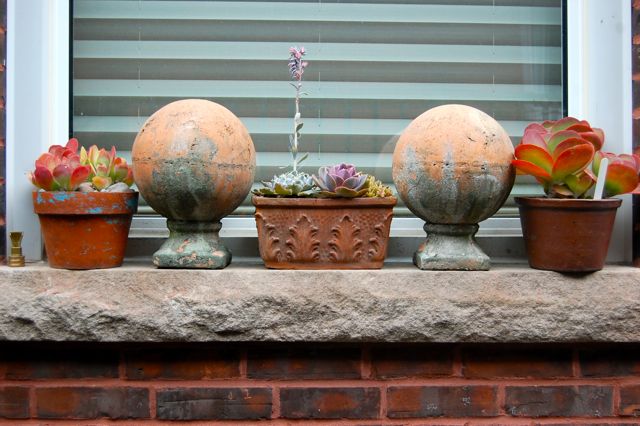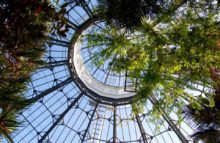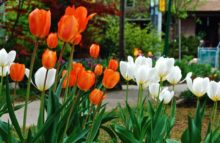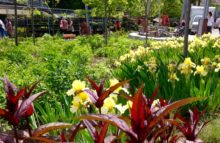Last Sunday, Sarah and Helen visited Barry Parker’s Open Garden Toronto and were once again blown away by this lovely Parkdale garden gem.
Helen: The first thing that impresses me about Barry’s garden is its structure. Structure is one of the things that moves a garden from good to great. And Barry proves that you don’t need to spend $100,000 on hardscaping to have an exceptional garden.
His garden spaces are defined by a circle of grass, curved box hedging and two obelisks of clipped beech. Pea gravel as paving. A couple of stone pillars at the entry made of recycled materials. Anyone could afford to do that. What did he say about the beeches?
Sarah: That he’d hacked at them last year because the walkway between was almost covered. Reminds me of something I learned in Master Gardeners. In Toronto in the 30s, it was fashionable for landscapers to plant blue spruce trees on either side of front walks, and of course the trees grew to enormous size and met in the middle. Holes had to be cut to walk through, ruining the shape of the tree. You can see examples all over the High Park area. But Barry’s beech trees look great pruned as obelisks.
Helen: Of course, there are the plants. You can’t talk about Barry’s garden without his collection, which is clearly a passion. Some degree of passion is essential for a great garden, I think.
It’s fun walking around the garden with Barry because he’s so enthusiastic, even about the tiniest little seedling – which, unlike my garden, wouldn’t be a weed. I bought one of his Ranunculus ‘Brazen Hussy’. Great name. [In other close-ups in this post, Fritillaria hermonis amana and the pale pink Sanguinaria canadensis ‘Armstrong’s Pink‘.]
In a collector’s garden like this, structure creates unity and cohesion. I’ve been a collector, in a far less exotic way. But my garden has that one-of bittiness that comes of focussing on plants rather than design. Barry’s strong lines using the box and beech tie it all together.
Then there are his surprising and inventive details. Inexpensive, too. Like the pedestal he made from stacked concrete pavers. Or a simple grouping of terra cotta pots. In almost every corner there’s something that makes you say, “Oh, wow. What a great idea. I could do that.”
Sarah: I could steal that, you mean. Barry’s eye for finding objects that he knows would look good in the garden is so inspiring.
His collection of spheres, placed just so, and oversized marbles tucked away in a corner. When you come across these things, they are tiny discoveries.
His creativity is so apparent when he uses objects in ways they weren’t designed for. That kind of thinking separates the good from the great. Putting metal obelisks along the top of his fence, for instance, rather than sticking them in the ground. Then repeating them along the length of the fence to say, “I did that on purpose.”
Helen: Repetition. One of the elements of good design.
And the secret woodland garden in the back. You mentioned how you like the layering.
Sarah: Yes, the way his perennials and shrubs are interplanted with medium shrubs and higher small trees really adds that three dimensional feel – like you’re in a little magical forest.
Helen: Uh huh. A great gardener considers the dimension “Up,” making use of all those levels and planes beyond the flat.
Sarah: I also love how he kept the old pale blue door as the entrance gate to the secret back garden. Others would have ripped door out and put it in the trash. But seeing that old blue door there reminds me of summers past and people banging through it. It has a place of honour at the end of the garden, inviting you to go through and explore.
Helen: I’m glad we went, and I’m actually glad it was raining so we had it more to ourselves. Barry’s such a lovely guy who takes an obvious delight in gardening and in people who like gardening, too.
He said he didn’t like it when people told him that looking at his garden made them feel depressed… that’s not the effect he wanted it to have at all. I feel uplifted when I come here. There are so many things about this garden that any of us could achieve.
[Open Gardens Toronto continues throughout the summer. We bought passports so we won’t miss anything.]











11 comments
I love all the contrasts in the garden–color, texture, shapes. Very nice.
This is a wonderful post! It not only gives us a tour of a beautiful garden, but also unpacks the design elements that make it so beautiful — such a great education for those of us who don't have a good intuitive sense of design. Thanks. -Jean
I love the multiple use of stone and rock in this design. Natural elements add such interest to a garden — they blend in unobtrusively while still adding an exciting feature. Great ideas, here.
I feel like I walked through this garden with the both of you (something I WISH I could do!) – thanks for the eloquent writing, and the gorgeous photos. I particularly enjoy how you break down this garden into it's different elements, explaining why each one works so well…beautifully done!
Helen, I love how you wrote this. So good. Post full of good information wittily written. Thanks for stopping by my blog today too.~~Dee
Love the she said, she said, tone of this post. Barrys garden is magical, there is so much going on I didn't even notice the obelisks on top of the fence, I shall have to look for that next time.
I visited Barry's Garden about two years ago. I'll never forget those beech trees. A beautiful garden all around and you have done a lovely job guiding us through it.
irena
It's nice to see all the diversity. That agave is very picturesque.
I don't get why people would tell him they are depressed after seeing his garden…out of jealousy/inadequacy? I enjoyed your dialogue. Another idea for what makes a garden great: a great gardener.
Christine in Alaska
A truly wonderful post about my favourite gardener.
loved the conversation taking us through Barry's much-loved garden